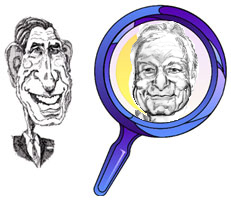
The Supply Store
Back to YouCan Draw.Com
Introduction
to Lesson 3: |
So by now, if you've you've completed lessons one and two, you're getting something of a feel for the left to right brain shift. If not, keep doing the exercises - it will come! You just might also find in this step, that you truly surprise yourself at what you CAN draw - if you can just free yourself from your doubting, dominating, logical "left" brain. You will be amazed.
Lesson three is a curious and fascinating step: Upside-Down Drawing. Even sounds kooky doesn't it? It's not drawing while you're standing on your head, or trying to make a drawing of someone doing a handstand - though that's actually a little closer to the truth of it!
Your Brain's Filing System
Here's the idea - and it stands on solid scientific and psychoneurologic fact. When you see something out there in the world, a chair for instance, and you name it as such, you pack that instance of "chair", along with every other object you've ever considered a chair into a little file in your brain called "chairs". It's there for quick reference, and like I mentioned on the YouCanDraw.Com home page, we'd all be wasting a lot of time, and possibly risking our lives reexperiencing and recategorizing everything we see, hear, feel, as if it were the first time we encountered it.
So if I asked you to draw a chair form memory (just
like you did with the face profiles in lessons one and
two), you'd access that memory bank of chairs. If I asked
you to draw a particular chair I placed in front of you,
again, if you hadn't been trained in seeing as an artist,
or if you hadn't stumbled upon that skill yourself, you'd
more than likely be drawing a "stockpiled"
image, or a "symbolic" chair from your L-mode's
memory banks. You'd ignore the chair you saw in front of
you.
Getting around Your Brains' Filing System
So the trick again here is to get you away from L-mode's analytic categorizing eye, and prevent it from seeing that chair (or any object you're trying to draw) as anything familiar. Because once L-mode can say "aha, it's a chair!", it's ready to move on to the next task - it's noted to itself "I know what this is", it thinks it's learned all it needs to know about it. And R-mode doesn't get a chance to loosen up and strut it's stuff.
 |
| An Example on the Fly |
Let me say that another way. As you're navigating through the world, most of the time there's no need to look at everything so closely. At this moment there's a fly buzzing around my head. (It's Southern California and I've got the door wide open to catch that Pacific breeze.) I see "fly" which pretty much triggers my "nuisance" button and I want to go after the thing swatting. "Dirty, disease, filth, garbage, alley scenes" all these associate in my brain. All I want to do is get rid of it.
I never think about the complex machinery inside it's chitin shell, or it's 15 different snouts, it's polygonal eyes, and the fact that NASA's top aeronautical engineer says this thing shouldn't even be flying. All those millions of years of evolution packed into one square centimeter of space just to irritate you and me.
A Closer Look
Now recall some of those electron microscope close-ups of insects: they look otherworldly. Nothing like anything any of us had ever seen before. The first time I saw those pictures, I was fascinated. I just stared. Same bug. When you look a little closer, or when you're allowed to look a little closer, the familiar becomes almost unrecognizable. And that's what this step is about. See what I mean:

Check out that detail!
Task: Making the Familiar, Unfamiliar
So the question becomes "So how do you make something familiar, unfamiliar? How do you make something familiar into something complex and thus making it a task the dominant, verbal L-mode gets so frustrated with it's got to step back and let the non-dominant, spatial R-mode fire-up? Good Question. (And a long sentence.)

"That can't be me"
And that's exactly what this step is all about: making the familiar complex, and thus allowing R-mode a chance at doing what it was made to do. And we do this by...
Upside-Down
Drawing
Betty Edwards, as far as I know, invented this exercise and made an astounding discovery. One day she half jokingly put up a picture for her class to draw - set it on the easel upside down. And to her astonishment, all of her students made a sudden, quantum leap in their drawing skills. So great and sudden was their improvement, she could only figure she stumbled on to a way to access a skill that had been idling there along, just overlooked. You'll be amazed how fast your drawing improves in this single exercise.
(Click for next page of Lesson Three)
Kasbohm & Company's
YouCanDraw.com
© Copyright, All rights reserved 1997
e-mail: jeffkaz@YouCanDraw